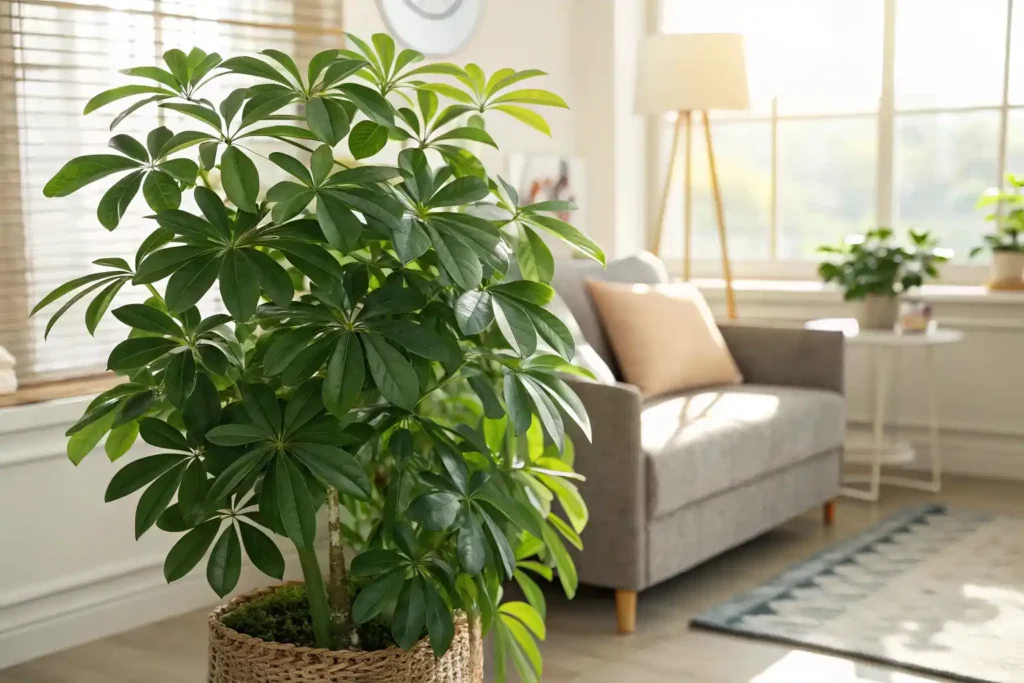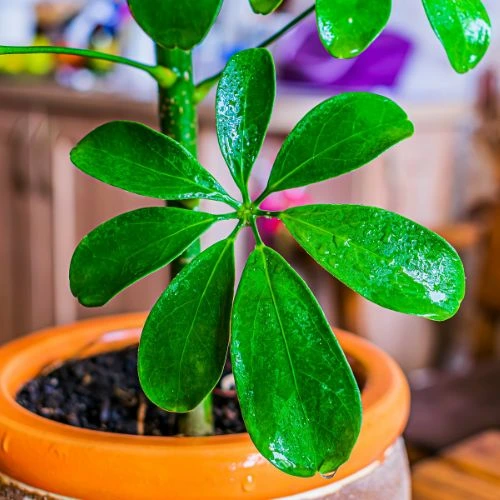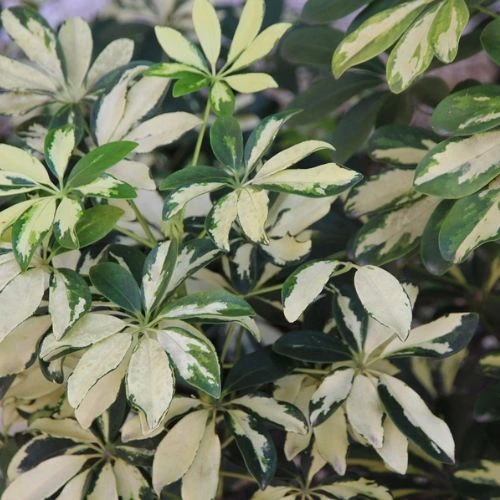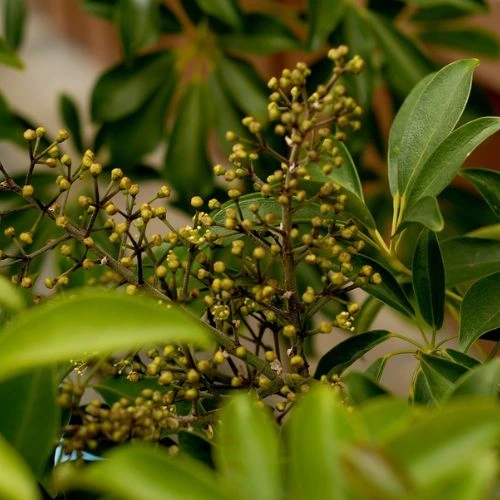Imagine walking into a room and instantly feeling a connection to nature—a lush, green Schefflera plant can transform any space into a calming oasis. Whether you’re a seasoned plant parent or just starting your journey, caring for a Schefflera isn’t just about maintenance—it’s about nurturing life and bringing vibrancy to your home. This guide will walk you through the essentials of Schefflera plant care, empowering you to keep your plant thriving while enjoying the simple joy it brings to your everyday life. Let’s get started!
In This Article
| Common Name | Umbrella Plant |
| Botanical Name | Schefflera spp. |
| Family | Araliaceae |
| Plant Type | Evergreen shrub/tree |
| Mature Size | 3-10 ft (indoors), up to 50 ft (outdoors) |
| Bloom Time | Rarely flowers indoors |
| Toxicity | Toxic to pets (mild to moderate) |
| Sun Exposure | Bright, indirect light; tolerates low light |
| Soil Type | Well-draining, loamy soil |
| Soil pH | Slightly acidic to neutral (6.0-7.5) |
| Flower Color | Red, white, or pink (outdoors, mature plants) |
| Hardiness Zones | 10-12 (USDA) |
| Native Area | Australia, Taiwan, Pacific Islands |

What Is a Schefflera Plant?
The Schefflera plant, commonly known as the umbrella plant, is a beloved houseplant admired for its lush, glossy leaves arranged in an umbrella-like pattern. Native to tropical regions like Southeast Asia and Australia, Schefflera plants bring a vibrant, exotic touch to your home. They’re popular not only for their beauty but also for their ease of maintenance, making them a favorite for both beginners and seasoned plant enthusiasts.
There are two common types of Schefflera: Schefflera arboricola (dwarf Schefflera) and Schefflera actinophylla (larger variety). Both thrive indoors when provided with the right care, but each has slightly different size and growth patterns. Dwarf Scheffleras, for instance, are ideal for small spaces, while larger varieties can grow into impressive indoor trees.
Proper Schefflera plant care ensures these plants remain healthy and vibrant year-round. They thrive in bright, indirect light, prefer consistent temperatures, and require moderate watering. With the right conditions, they can grow quickly, enhancing the ambiance of your space.
Whether you’re looking to brighten your living room or create a tropical feel in your home, the Schefflera plant is an excellent choice. Start your journey today by mastering the essentials of Schefflera plant care!
Choosing the Perfect Spot for Your Schefflera
Selecting the right spot for your Schefflera is the first step in mastering Schefflera plant care. These tropical beauties thrive in bright, indirect light, mimicking their natural habitat under the forest canopy. A sunny room with filtered light is ideal, but avoid direct sunlight, which can scorch their delicate leaves. If the lighting is too low, their growth may become slow and spindly, leaving your plant looking less vibrant.
Temperature plays an equally important role. Schefflera plants prefer a range of 60–75°F (15–24°C) and should be kept away from cold drafts or sudden temperature fluctuations. Air conditioning vents, heaters, and open windows can cause stress, leading to yellowing or dropping leaves.
Humidity is another key factor. While they can adapt to typical indoor conditions, Scheffleras flourish in slightly humid environments. If your home is dry, especially during winter, consider using a humidifier or placing a tray of water with pebbles near the plant.
By positioning your Schefflera in a stable, well-lit, and humidity-friendly spot, you’ll set the foundation for a thriving plant. Remember, attentive placement is a crucial part of effective Schefflera plant care, ensuring your greenery stays healthy and vibrant.



Caring for Your Schefflera Plant
Proper care is essential to help your Schefflera thrive, ensuring it stays healthy and vibrant. From watering routines to choosing the right soil and fertilizer, here’s how to master Schefflera plant care.
Mastering the Art of Watering
Watering your Schefflera correctly is vital for its health. For optimal growth, these plants need their soil to dry slightly before being watered again. Use your finger to check the top inch of soil; if it is dry, watering is required. Typically, once a week during the growing season (spring and summer) is sufficient, while less frequent watering is needed during cooler months.
Overwatering can lead to root rot, which shows as yellowing leaves and drooping stems. Ensure your pot has drainage holes, and never let water sit at the bottom of the container. Conversely, underwatering can cause the leaves to droop and become brittle.
Always use room-temperature water to prevent shocking the roots.Allow chlorinated tap water to sit for 24 hours to dissipate the chlorine before using it. Regular, balanced watering is a key part of successful Schefflera plant care.
Soil and Repotting Tips for Schefflera Plants
Schefflera plants thrive in well-draining potting soil rich in organic matter. A mix designed for houseplants or one combining peat, perlite, and compost works well. Avoid using dense soils that retain excessive moisture.
Repot your Schefflera every 2–3 years or when it outgrows its current pot. Signs it’s time to repot include roots growing through drainage holes or visibly circling inside the pot. Choose a slightly larger pot to give the roots space to expand.
When repotting, handle the roots gently and remove any that appear damaged or rotten. Fresh soil will not only provide essential nutrients but also improve drainage. This is a vital aspect of ongoing Schefflera plant care.
Fertilizer: When and How to Feed Your Schefflera
Fertilizing helps your Schefflera grow lush and vibrant. During the growing season, feed it with a balanced, water-soluble fertilizer (e.g., 20-20-20) every 4–6 weeks. Dilute the fertilizer according to the package instructions to avoid overfeeding, which can lead to salt buildup in the soil.
During winter, decrease feeding as the plant’s natural growth rate declines. To keep your plant healthy, flush the soil with water occasionally to prevent salt accumulation. Proper feeding is an essential part of effective Schefflera plant care, promoting strong, healthy growth.
By following these watering, soil, and fertilizing tips, your Schefflera will flourish, adding beauty and life to your home!
Pruning for a Healthy, Attractive Schefflera
Pruning is an essential part of Schefflera plant care, keeping your plant looking vibrant and encouraging healthy growth. Regular pruning helps maintain its shape, prevents legginess, and promotes fuller foliage.
The best time to prune a Schefflera is during spring or early summer when the plant is actively growing. Start by examining your plant for any yellowing, damaged, or dead leaves, as these can sap energy from the healthy parts of the plant. Using clean, sharp pruning shears, trim these leaves and any stems that appear unhealthy.
For shaping, identify branches that are growing unevenly or too long. Make your cuts just above a leaf node at a 45-degree angle to encourage new, bushy growth. Avoid heavy pruning all at once; instead, trim gradually over time to avoid stressing the plant.
If your Schefflera becomes too tall, you can cut back the main stem. This not only reduces its size but also stimulates the growth of new shoots from the base, creating a fuller appearance.
With regular pruning as part of your Schefflera plant care routine, you’ll maintain a healthy, attractive plant that continues to brighten your space with its lush, green leaves.
How to Identify and Solve Common Pests and Problems
Like any houseplant, Schefflera plants can face challenges, but with proper Schefflera plant care, you can quickly identify and resolve issues to keep your plant thriving.
Common Pests
Schefflera plants may attract pests like spider mites, scale insects, and mealybugs. These pests feed on the plant’s sap, causing leaf discoloration, drooping, or sticky residue on the foliage. Regularly check your plant, focusing on leaf undersides, to spot infestations early.
Solutions:
- Use a damp cloth to wipe the leaves for minor infestations.
- Use neem oil or insecticidal soap for more severe cases. Apply weekly until pests are gone.
- Quarantine the plant if pests spread to nearby plants.
Diseases
Overwatering is a leading cause of root rot, a common problem in Scheffleras. Root rot symptoms include yellowing leaves, wilting, or a foul smell from the soil. Address this by improving drainage, reducing watering frequency, and repotting the plant in fresh soil if needed.
General Troubleshooting
- Yellow Leaves: Are often a result of overwatering or lack of light. Adjust your care routine accordingly.
- Leggy Growth: Indicated by long, thin stems due to inadequate light. Move the plant to a location where it can receive more brightness.
With vigilance and proper Schefflera plant care, you can prevent pests and diseases, ensuring your plant stays healthy and beautiful.
Seasonal Care for Schefflera Plants
Seasonal adjustments are an essential part of Schefflera plant care, as your plant’s needs change with the weather. Understanding these shifts will help your Schefflera thrive year-round.
Spring and Summer
During the growing season, your Schefflera will be more active, requiring increased attention. Water your plant regularly, ensuring the soil dries out slightly between waterings. This is also the best time to fertilize every 4–6 weeks with a balanced, water-soluble fertilizer to encourage lush growth. Bright, indirect light is crucial during this period, as it fuels the plant’s development.
Spring and summer are also ideal for repotting if needed, as the plant’s roots are actively growing. Pruning can help shape your Schefflera and stimulate bushier growth.
Fall and Winter
As temperatures drop and sunlight becomes less intense, your Schefflera’s growth will slow. Reduce watering frequency to avoid soggy soil, and stop fertilizing until spring. Make sure the plant is in a stable environment away from cold drafts, as sudden temperature drops can stress the plant.
Low indoor humidity during winter can be managed by misting the leaves or placing a humidifier nearby.
Adapting your routine to the seasons ensures your Schefflera plant care remains effective, helping your plant stay healthy and vibrant throughout the year.
FAQs
How often should I water my Schefflera?
Water your Schefflera once the top inch of soil feels dry. Be cautious not to cause overwatering which can lead to root rot, so ensure the pot has proper drainage.
Why are my Schefflera’s leaves turning yellow?
Yellow leaves often indicate overwatering, insufficient light, or poor drainage. Adjust your watering routine and ensure the plant gets bright, indirect light.
Can Schefflera plants grow in low light?
While Schefflera plants tolerate low light, they thrive in bright, indirect light. Prolonged low-light conditions may result in leggy growth and sparse leaves.
How do I make my Schefflera bushier?
Prune leggy stems just above a leaf node to encourage fuller growth. Pinching off new growth tips also helps.
What pests affect Schefflera plants?
Pests like spider mites, mealybugs, and scale insects are common. Inspect your plant frequently and use neem oil or insecticidal soap to treat any infestations.
Recap
- Light: Place your Schefflera in bright, indirect light. To prevent leaf burn direct sunlight is not required.
- Watering: Water whenever having observed that the top inch of soil is dry. To avoid root rot, use room-temperature water and ensure proper drainage.
- Soil: Use well-draining, nutrient-rich potting soil. A peat, perlite, and compost mix works best.
- Humidity: Maintain moderate humidity. Mist the leaves or use a humidifier during dry seasons.
- Fertilizer: Feed ,during spring and summer, with a balanced fertilizer every 4–6 weeks Skip feeding in fall and winter.
- Pruning: Regularly prune to remove dead leaves and maintain shape. Trim leggy stems for a bushier plant.
- Seasonal Care: Adjust watering and lighting based on the season. Protect from cold drafts in winter.
- Pests: Inspect regularly for spider mites, mealybugs, or scale. if needed, use insecticidal soap or neem oil as treatment.
Conclusion
Caring for a Schefflera plant is rewarding, bringing beauty and a sense of tranquility to your home. With the tips shared in this guide, you’ll confidently maintain a healthy, thriving Schefflera that brightens your space year-round. Curious to learn more about plants and gardening? Subscribe to our newsletter for expert advice, inspiration, and exclusive updates tailored to your gardening journey!

